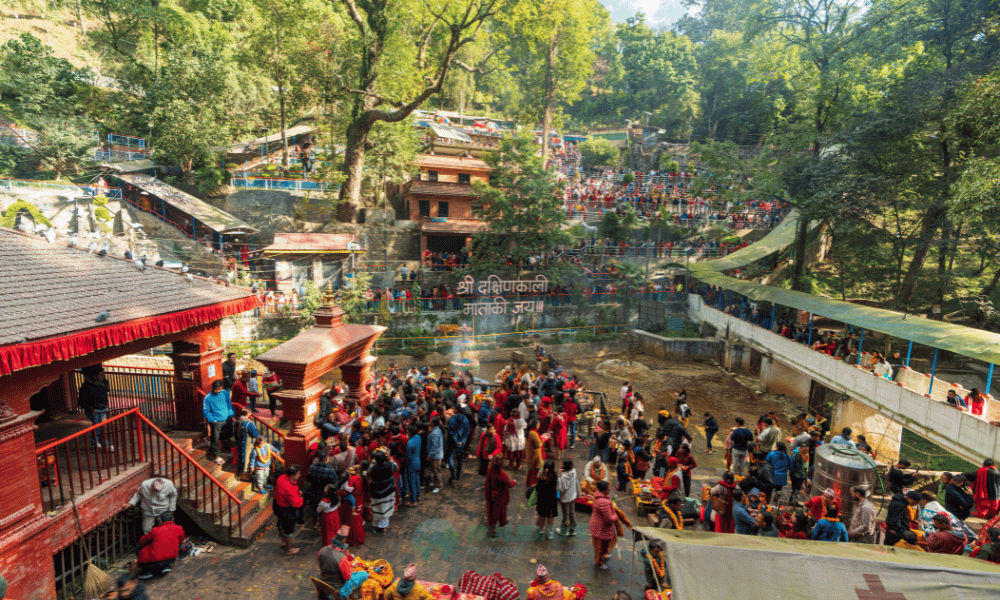The Dakshinkali Temple in Nepal's Kathmandu Valley is an everlasting symbol of faith, devotion, and the unbreakable connection between spirituality and nature. The words "Dakshin," which means "south," and "Kali," the name of the god worshiped in the temple, are combined to make Dakshinkali (The kali of the south). This sacred temple, dedicated to the fearsome deity Kali, draws all those seeking greater respect for Nepal's rich religious tapestry. As we start this journey, we step into a world where traditions have been passed down for hundreds of years, where the deity's fierce but protective aura can be felt, and where the peaceful beauty of nature wraps every visitor in a calm embrace.
Dakshinkali Temple, located just a short journey from the bustling city of Kathmandu, is a captivating blend of spirituality and scenic beauty. Here, devotees and explorers gather to pay respect to the deity Kali, who represents both power and protection. Her numerous arms are embellished with sacred symbols, signifying her dominance over various facets of existence. The temple's sacredness is heightened by the Bagmati River's soothing sounds and the lush hills that surround the temple.
In addition to its religious significance, the Dakshinkali Temple is a cultural treasure repository where age-old rituals and customs are brought to life. It is a site where the rhythms of daily life blend with spiritual traditions passed down through generations. Join us on this journey into the heart of Dakshinkali, where we will unravel the temple's mysteries, learn about its origins and history, and embrace the deep connection between the divine and the natural world.
Dakshinkali Temple Facts
|
Site |
Dakshinkali |
|
Affiliation |
Hinduism |
|
Deity |
Goddess Kali |
|
Location |
Pharping, Kathmandu |
|
Established by |
King Pratap Malla (Malla Dynasty) |
|
Major Attractions |
|
|
Major Celebrations |
|
|
Style |
Newari Style |
|
Opening Hours (main temple) |
06:00 AM -11:00 AM 01:00 PM - 06:00 PM |
|
Entry Fee |
No Entry fee |
History and Mythology
Dakshinkali Temple, a revered Hindu temple in Nepal, can be traced back to ancient legends and mystical tales. The temple's history is linked to the worship of Kali, a symbol of divine femininity and strength. According to local mythology, the establishment of the temple was inspired by a dream in which deity Kali herself visited a farmer. During this spiritual encounter, she expressed her desire to be worshiped at a specific location, which eventually became Dakshinkali Temple.
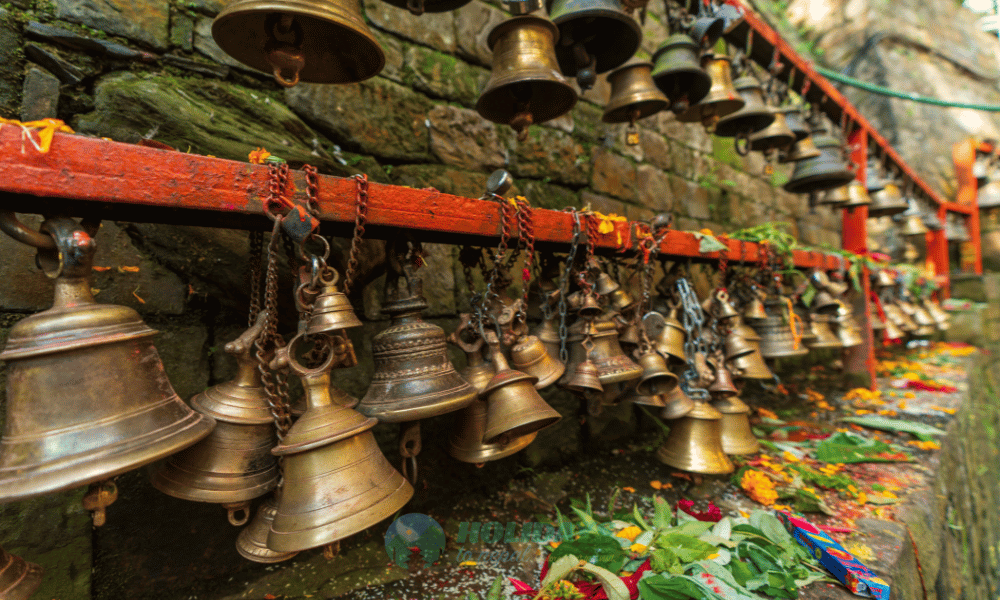
In another mythology, it is believed that the Goddess Kali appeared in a dream of King Pratap Malla who reigned over Nepal in the 14th century. The goddess supposedly ordered the king to construct a temple which would be devoted to her. The king then set out to follow her orders immediately, and as a result of this divine revelation, construction of the temple commenced, and over the centuries it has grown into an important spiritual center.
The Dakshinkali Temple holds a unique place in Nepal's religious, cultural, and historical traditions. Devotees from Nepal and beyond have traveled to this sacred site for centuries to seek the blessings and protection of the goddess Kali, particularly in times of difficulty. The temple's rituals, such as the daily animal sacrifices, are rooted in time-honored traditions and represent the goddess's role as protector against evil forces.
As a spiritual and historical pillar of Nepal, the origin and history of Dakshinkali Temple are deeply rooted in the cultural fabric of the nation. It symbolizes the enduring connection between the Nepalese and the divine, where mythology and religion combine to create a sacred space that has withstood the test of time.
Religious and Cultural Significance
The Dakshinkali Temple in Nepal exemplifies the profound integration of religious and cultural significance. At its center, the temple is a symbol of the Nepali people's unwavering faith and spiritual devotion. Devotees from all over Nepal and the world come to this sacred site to pay respect to the goddess Kali and request her divine blessings and protection. The rituals of the temple, including the daily animal sacrifices, are deeply rooted in religious tradition and represent the goddess's role as a fierce protector against evil forces.
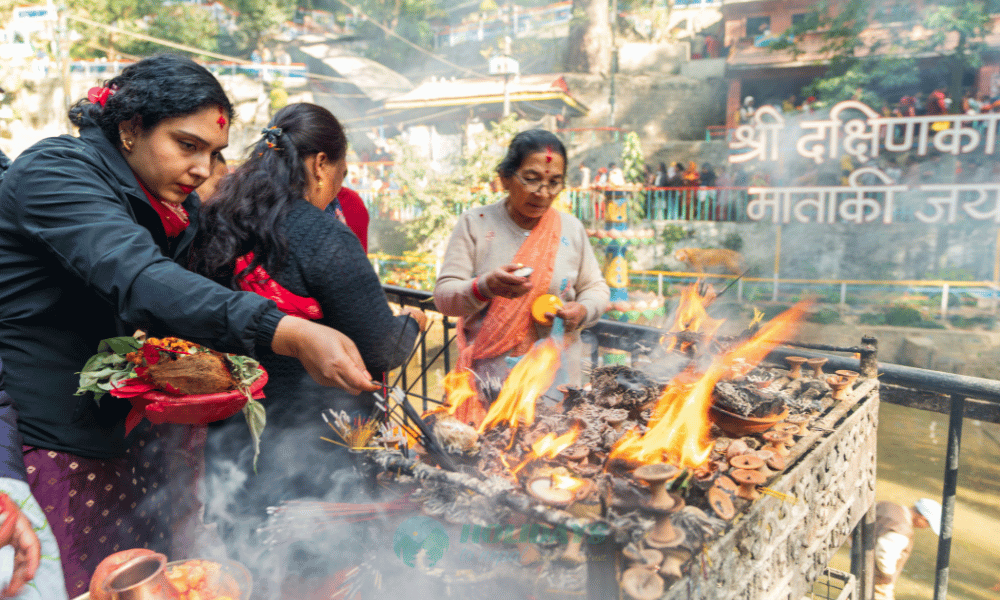
Dakshinkali Temple is an essential component of the cultural tapestry of Nepali traditions. It is a living collection of age-old customs and practices, a location where rituals have been carefully carried out for generations. The cultural significance of Dakshinkali's festivals, such as Dashain, is profound, drawing communities together to honor and preserve their rich heritage. The temple's architecture, which reflects traditional Nepalese emotions, is evidence of the region's enduring cultural identity.
The peaceful natural surroundings of the temple, nestled between lush hills and the running Bagmati River, emphasize the harmonious coexistence of religion and nature. This peaceful setting makes it easy for people to connect with the holy and enjoy the beauty and peace of the natural world. Therefore, Dakshinkali Temple is a broad representation of Nepal's cultural and spiritual essence, where faith and tradition are inseparable from the landscapes that nurture it.
Major Attractions
The major attractions in Dakshinkali Temple encompass the awe-inspiring idol of Goddess Kali, the captivating natural surroundings with lush hills and the Bagmati River, and the temple's traditional Nepali architecture.
Kali’s Idol
Goddess Kali's statue in Dakshinkali Temple is a striking example of divine power and symbolism. The two-foot-tall deity, carved from a single piece of black stone, is one of the most formidable and revered symbols in the temple.

The statue of the goddess Kali is unique in a number of ways. She is shown to have several arms, each of which is clutching a different item or weapon that has special significance. The idol has a necklace of demon heads which symbolizes Kali's role as a fierce protector and slayer of evil. The three eyes on Kali's idol, which stand for the sun, moon, and fire, allow her to see in three different time frames: the past, present, and future. This characteristic is also where the name Kali, which is the feminine version of the Sanskrit word for time, "Kala," came from. Her protruding tongue and wide-open eyes serve as a physical picture of her triumph against evil forces. During celebrations, she is adorned with several pieces of jewelry like crowns and necklaces. To represent the cosmic balance between creation and destruction, the idol is placed atop a lying-down representation of Lord Shiva.
Devotees and visitors to Dakshinkali Temple are frequently amazed by the idol's imposing presence, making it the central point of worship and reverence within the temple complex.
Temple’s Architecture
The architectural design of Dakshinkali Temple is a remarkable example of traditional Nepali art and craftsmanship. The cultural and historical significance of the temple complex is enhanced by its carefully carved wooden structures, stone sanctuaries, and ancient artwork.
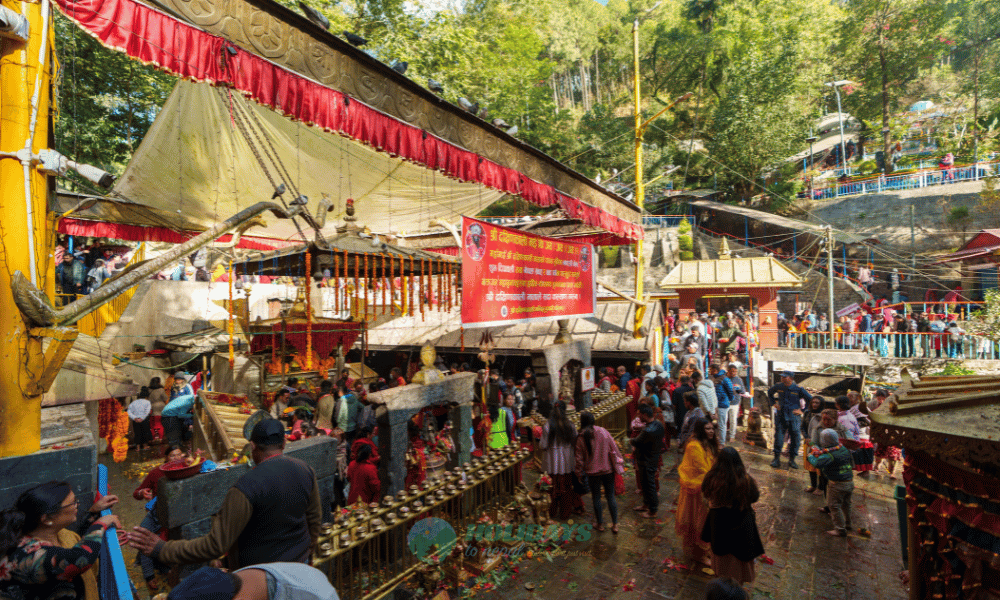
The main temple structure follows the distinctive Newari architectural style that is common throughout the Kathmandu Valley. Its multi-tiered pagoda-style roof is distinguished by its intricately carved pillars and windows. The wooden pillars and columns of the temple display the exquisite woodworking skills of Nepalese craftsmen through their intricate carvings of mythological figures and complex patterns.
Smaller shrines and structures, each reflecting traditional Nepalese architecture, surround the main temple. These structures are decorated with religious symbols and sacred artwork, producing a harmonious combination that feels spiritual and represents cultural history. The entire complex sits within the peaceful setting of the Bagmati River and surrounding hills, enhancing the architectural beauty and natural connection to the temple. The architecture of Dakshinkali Temple is a living proof to Nepal's unwavering commitment to preserving its architectural heritage and its rich cultural heritage.
Natural Beauty
The natural beauty that surrounds Dakshinkali Temple is spectacular, providing tourists with a peaceful and beautiful backdrop to their spiritual experience. The temple's setting is a wonderful fusion of peace and unspoiled beauty, nestled among the lush hills of the Kathmandu Valley and next to the trickling Bagmati River.
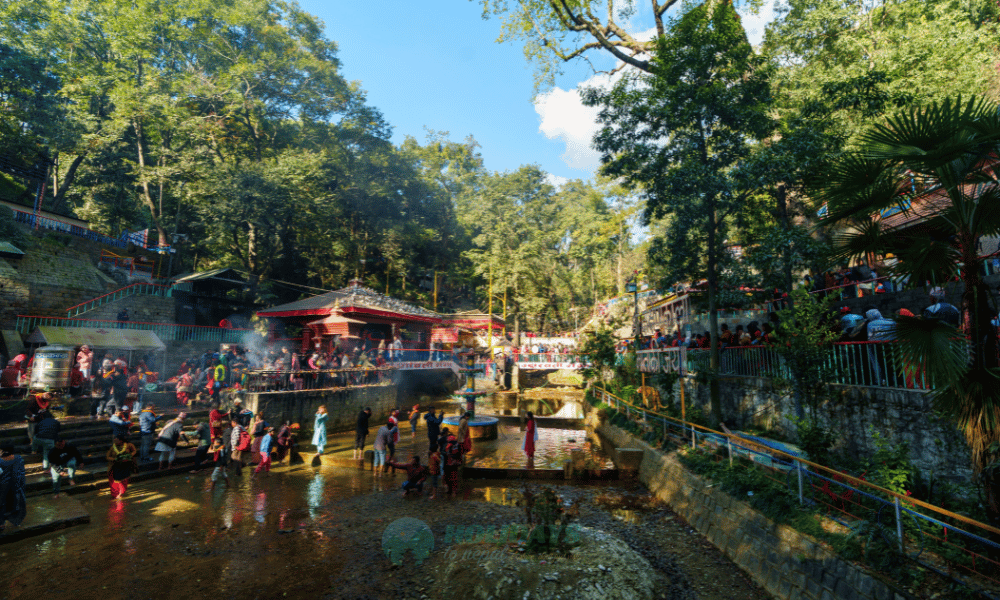
The surrounding hills and lush vegetation of the temple complex give it a feeling of isolation and tranquility. These hills provide a peaceful break from modern life, inviting travelers to submerge themselves in natural tranquility. The lush scenery enhances the temple's aura, giving it a great venue for reflection and meditation.
The smooth flow of the Bagmati River, which runs alongside the temple, adds to the natural appeal. Its clear waters stream down the valley, mirroring the surrounding hills and providing a relaxing soundtrack that enhances the spiritual atmosphere of the temple. Visitors often find comfort in sitting by the riverbanks, taking in the peaceful sights and sounds while connecting with nature.
Overall, the natural setting around Dakshinkali Temple is an important aspect of the temple's visual appeal, enabling visitors to not only join in the spiritual experience but also to appreciate Nepal's natural beauty. It's a location where faith and nature coexist seamlessly, creating an immersive and fascinating setting for both devotees and explorers.
Major Festivals
Dakshinkali Temple hosts several major celebrations and festivals throughout the year, drawing large crowds of devotees and visitors. These celebrations are deeply rooted in religious tradition and cultural significance, making them vibrant and memorable events:
Dashain
Dashain, also known as Vijaya Dashami, is Nepal's most significant and widely celebrated Hindu festival, and Dakshinkali Temple plays an important role in the celebrations. Dashain normally occurs in September or October and is celebrated for 15 days since it represents the goddess Durga' victory against the buffalo demon Mahishasura. During this auspicious time, devotees and visitors go to Dakshinkali Temple to participate in the festival's rites and celebrations.
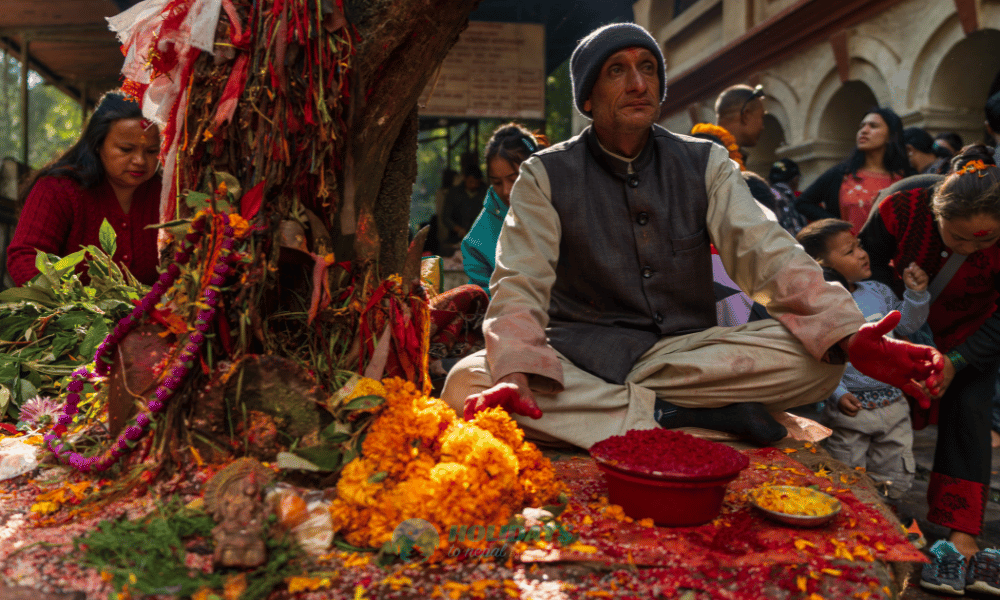
The offering of sacrifices to goddess Kali is one of the most important components of Dashain at Dakshinkali Temple. Devotees bring animals to be sacrificed, typically goats and chickens, as a symbolic way of pleasing the goddess and asking her blessings. The temple complex becomes a center of activity, with huge lines of people eager to perform these sacred ceremonies. As pilgrims from all over the world arrive, the atmosphere is filled with devotion and excitement.
Dashain also includes cultural events, processions, and traditional music and dancing at temples. The colorful and joyful atmosphere surrounds the temple complex. During this important festival, families gather to offer prayers, receive blessings, and enjoy a sense of togetherness. Dashain at Dakshinkali Temple is a cultural and spiritual event that allows devotees and tourists alike to immerse themselves in Nepal's rich traditions while also celebrating the goddess Kali with great devotion and delight.
Learn More: Dashain Festival
Kalika Jayanti
At Dakshinkali Temple, Kalika Jayanti is a massive celebration dedicated to the goddess Kali's birth or appearance, marking an important date in the temple's annual calendar. This sacred celebration attracts thousands of believers and visitors who come to celebrate and pay homage to the powerful and revered goddess.
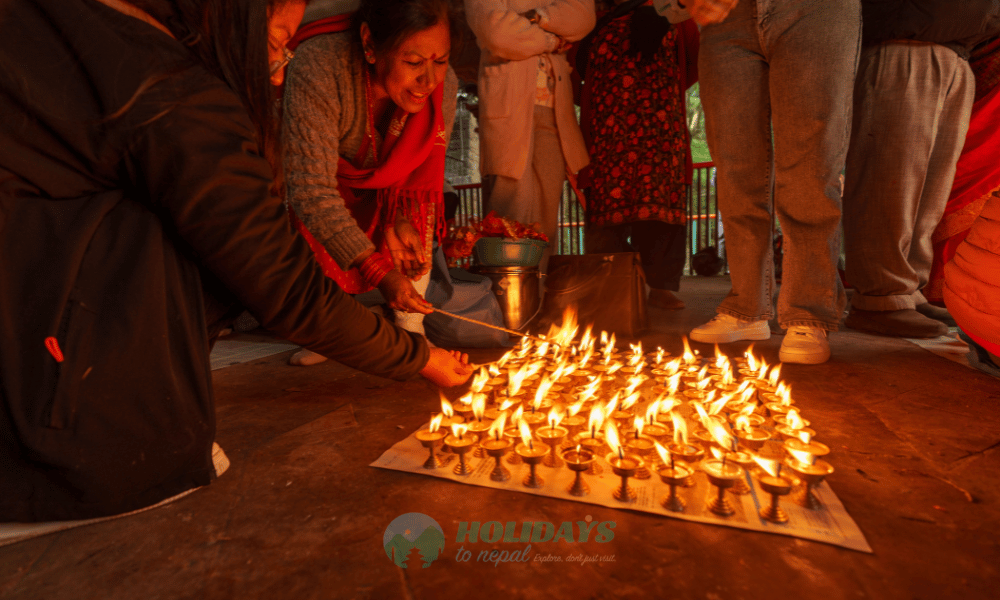
Kalika Jayanti is celebrated on the eighth day of the bright half-moon in the Nepali month of Baisakh, which corresponds to April or May in the Gregorian calendar. On this auspicious day, Dakshinkali Temple comes to life with vibrant rituals and intense devotion. Devotees from all over Nepal and beyond flock to the temple to offer prayers and seek the goddess' blessings.
Special pujas (worship ceremonies) are performed by temple priests as part of the celebrations. The melodic sounds of traditional music and chants permeate the air, creating a spiritually charged environment. Devotees send flowers, fruits, and incense as offerings, and the temple is decorated with beautiful decorations. As an expression of devotion and surrender to the goddess, the celebration generally concludes with the offering of sacrifices, primarily of animals such as goats and chickens.
Kalika Jayanti is a significant cultural and religious event celebrated at Dakshinkali Temple, where ancient traditions and modern devotion merge. It offers a glimpse into Nepal's spiritual heritage and the people's enduring connection to the fierce goddess Kali, who continues to inspire reverence and admiration throughout the centuries.
Shivaratri
Shivaratri, Lord Shiva's Great Night, is celebrated with great enthusiasm and devotion at Dakshinkali Temple, giving an additional layer of spiritual significance to this already respected site. Shivaratri, which translates to "the night of Shiva," is a major Hindu festival celebrated in Nepal and around the world.
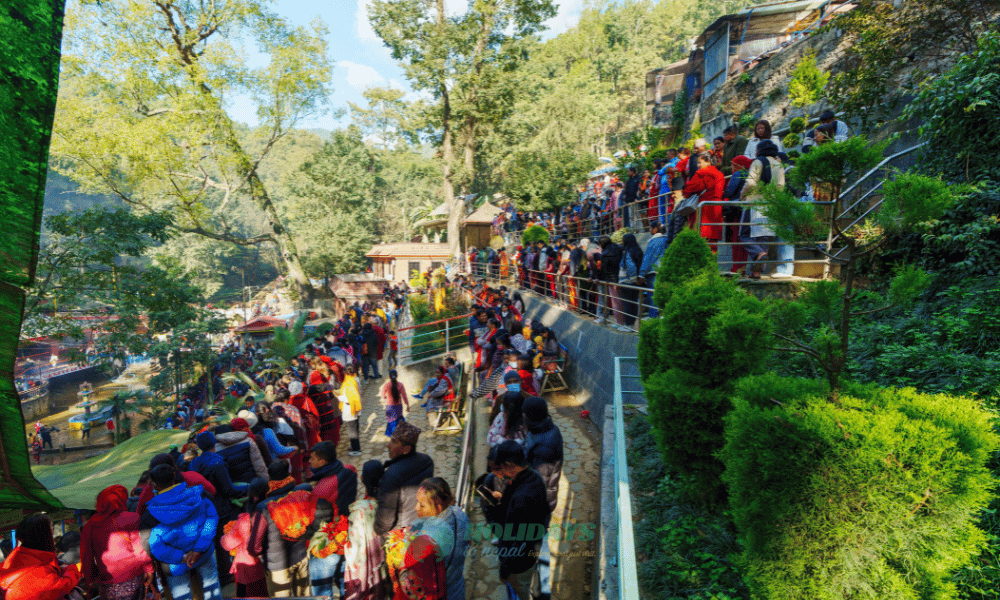
The Shivaratri celebrations at Dakshinkali Temple are a unique blend of goddess Kali and Lord Shiva worship, representing the harmonious character of Hinduism. Devotees from all over flock to the temple, creating a dynamic and spiritually charged atmosphere. The temple complex is brightly decorated, and priests perform special pujas (worship rituals) throughout the day and night.
Offering goat and chicken sacrifices as a show of devotion and surrender to the divine is one of the characteristic features of Shivaratri at Dakshinkali Temple. The temple grounds come alive with activity as priests and followers execute rites, and the scent of incense and flowers fills the air. The neighboring sacred Bagmati River plays an important role in the festivities, as followers take ritual showers and offer prayers along its banks.
The night of Shivaratri is especially auspicious, with devotees remaining awake to engage in prayers and meditation throughout the night. The sounds of traditional music and chants echo around the temple, creating an intense spiritual atmosphere. Shivaratri at Dakshinkali Temple is a tribute to Nepal's deep-rooted faith and cultural richness, as both goddess Kali and Lord Shiva are worshiped in a harmonic celebration of devotion and spirituality.
Learn More: Maha Shivaratri Festival In Nepal
Nepali New Year
The Nepali New Year, also known as "Nepal Sambat" or "Nepal Samvat," is a festive and culturally significant event celebrated with passion and reverence at Dakshinkali Temple. This New Year's celebration marks the start of the Nepal Sambat calendar, which dates back to the legendary reign of King Siddhartha Lichhavi. Dakshinkali Temple's celebrations are a unique blend of cultural traditions and spiritual devotion.
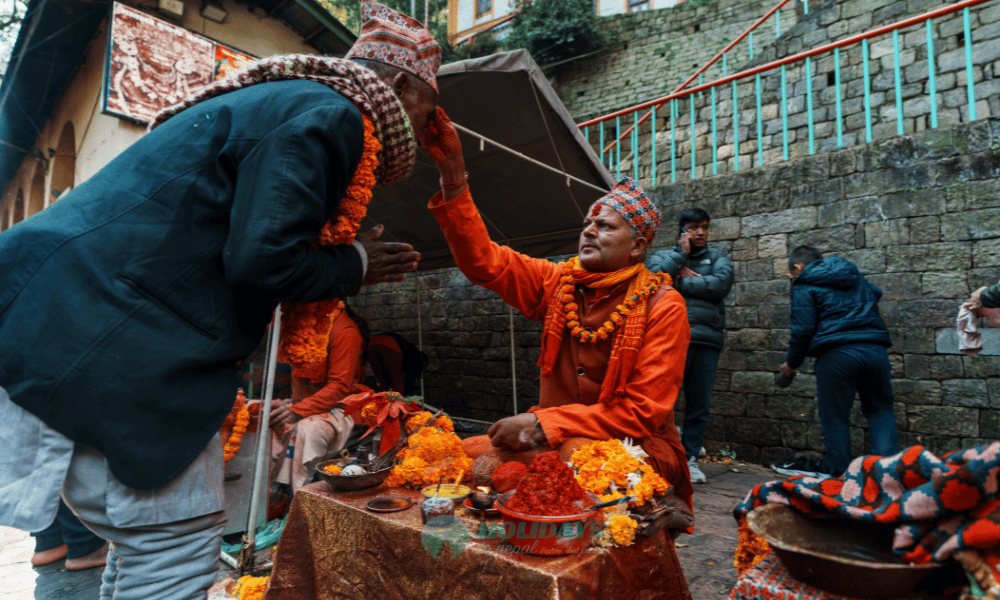
Devotees and visitors rush to the temple on Nepali New Year's Day to seek goddess Kali's blessings for a bright and auspicious year ahead. The temple complex is beautifully decorated and the air is filled with the sounds of traditional music and chants. To honor the occasion, priests perform special pujas (worship ceremonies) requesting the divine presence of goddess Kali.
The offering of various objects to the deity, such as fruits, flowers, and other symbolic offerings, is an important part of the festival. The colors of these offerings bring the temple grounds to life and make for a beautiful sight. Furthermore, the Bagmati River, which flows near the temple, plays an important role in the celebration, with devotees taking ceremonial baths and performing sacred ceremonies along its banks. Nepali New Year at Dakshinkali Temple is witness to Nepal's strong cultural and spiritual legacy, where age-old traditions continue to survive, and the goddess Kali is worshiped as the goddess of new beginnings and blessings.
How to Reach
Dakshinkali Temple is located approximately 22 kilometers southwest of Kathmandu, Nepal's capital city. There are several ways to reach the temple:
By Road (Private Vehicle or Taxi):
The most convenient way to reach Dakshinkali Temple is by hiring a private vehicle or taking a taxi from Kathmandu. One can easily find taxis or book them in advance in Kathmandu. The temple is approximately 22 kilometers (about 13.7 miles) from Kathmandu, and the drive takes around 45 minutes to an hour, depending on traffic and road conditions. The road is well-maintained, and the drive offers scenic views of the surrounding hills and countryside.
By Public Bus:
Public buses also operate from Kathmandu to Dakshinkali Temple. You can catch a bus from different locations within Kathmandu, such as Kalanki Bus Park or New Bus Park.
Be prepared for a longer journey, as public buses may make multiple stops along the way and can be crowded. The ride provides an opportunity to experience local life and culture.
Note: It's recommended to check the temple's opening hours and any local regulations or customs, particularly if you plan to visit during a festival or special event, as there may be variations in accessibility and activities during these times.
Things to Remember
Before visiting Dakshinkali Temple in Nepal, there are several important considerations to keep in mind to ensure a respectful and enjoyable experience:
Respectful Attire
As a religious site, modest and respectful attire is essential. Visitors are encouraged to dress conservatively, covering their shoulders and knees. Avoid wearing revealing or skimpy clothing, and remove your shoes before entering the temple premises.
Photography and Videography
While photography is generally allowed in the temple complex, be mindful of your surroundings and ask for permission before taking photos of people, especially devotees engaged in worship. During rituals or sensitive moments, it's advisable to refrain from taking pictures or recording videos.
Animal Sacrifices
Understand that animal sacrifices are a fundamental part of the temple's rituals. If you find this practice uncomfortable or distressing, it's essential to respect the religious beliefs of others and decide whether or not to witness these ceremonies.
Timing
Consider the timing of your visit, especially if you wish to avoid crowds. Dakshinkali Temple can get quite busy during festivals and auspicious days. Weekdays and early mornings tend to be quieter times to visit.
Respect for Local Customs
Be mindful of local customs and traditions. For example, it's customary to walk around the temple's shrine in a clockwise direction, and it's considered respectful to bow or offer a small donation to the temple.
Transportation
Plan your transportation to and from the temple in advance. If you're hiring a taxi or a private vehicle, arrange for a return journey, as public transportation options can be limited, especially in the evening.
Conclusion
Finally, Dakshinkali Temple is a tribute to Nepal's rich tapestry of cultural and religious traditions. This sacred site, nestled among the beautiful hills of the Kathmandu Valley and alongside the holy Bagmati River, is more than just a place of worship; it is a vibrant representation of Nepal's deep spiritual relationship with the divine.
The temple's significance extends beyond its amazing architecture and Goddess Kali statue. It symbolizes the peaceful relationship of faith and nature, where believers and visitors alike can find shelter amidst the peaceful scenery. The rites and festivals observed here offer a unique glimpse into Nepal's deeply rooted traditions, and the daily practices, including animal sacrifices, testify to the faithful's unwavering dedication.
Visitors to Dakshinkali Temple are invited to immerse themselves in a world where spirituality, culture, and nature coexist in perfect harmony. It is a place where the religious and the scenic blend to produce a remarkable experience—a journey that captures the essence of Nepal's spiritual soul as well as the everlasting beauty of its surroundings.
Also Read: Pashupatinath Temple | Budhanilkantha Temple
Frequently Asked Questions (FAQs)
Here are some frequently asked questions (FAQs) about Dakshinkali Temple.
What is the significance of Dakshinkali Temple?
Dakshinkali Temple is dedicated to Goddess Kali, a powerful Hindu deity associated with protection and destruction. The temple holds religious significance as a place of worship and rituals dedicated to the goddess.
Where is Dakshinkali Temple located?
Dakshinkali Temple is located approximately 22 kilometers southwest of Kathmandu, Nepal's capital city, in the Kathmandu Valley.
Are animal sacrifices performed at Dakshinkali Temple?
Yes, animal sacrifices, including goats and chickens, are part of the temple's daily rituals and major festivals. These sacrifices are made to seek the blessings and protection of Goddess Kali.
Can tourists and non-Hindus visit Dakshinkali Temple?
Yes, tourists and non-Hindus are welcome to visit the temple. It's important to be respectful of the temple's customs, traditions, and religious practices while visiting.
When is the best time to visit Dakshinkali Temple?
The temple is open year-round, but it's advisable to visit during weekdays or early mornings to avoid crowds. Major Hindu festivals like Dashain offer a unique cultural experience but can be crowded.
Are there any nearby attractions to visit in the area?
Yes, the surrounding area offers opportunities for hiking and exploration of the lush hills. Additionally, Shikali Mai Temple and other cultural sites can be explored nearby.
Is there an entry fee to visit Dakshinkali Temple?
There is no official entry fee for Dakshinkali Temple.
What should I wear when visiting Dakshinkali Temple?
Although there are no restrictions, visitors are advised to dress modestly, covering their shoulders and knees. Avoid wearing revealing or skimpy clothing, and remove your shoes before entering the temple premises.
How can I get to Dakshinkali Temple from Kathmandu?
You can reach Dakshinkali Temple by hiring a private vehicle or taxi, taking a public bus, or even by hiking from various points in the Kathmandu Valley. Hiring a private vehicle or taxi is the most convenient option.

